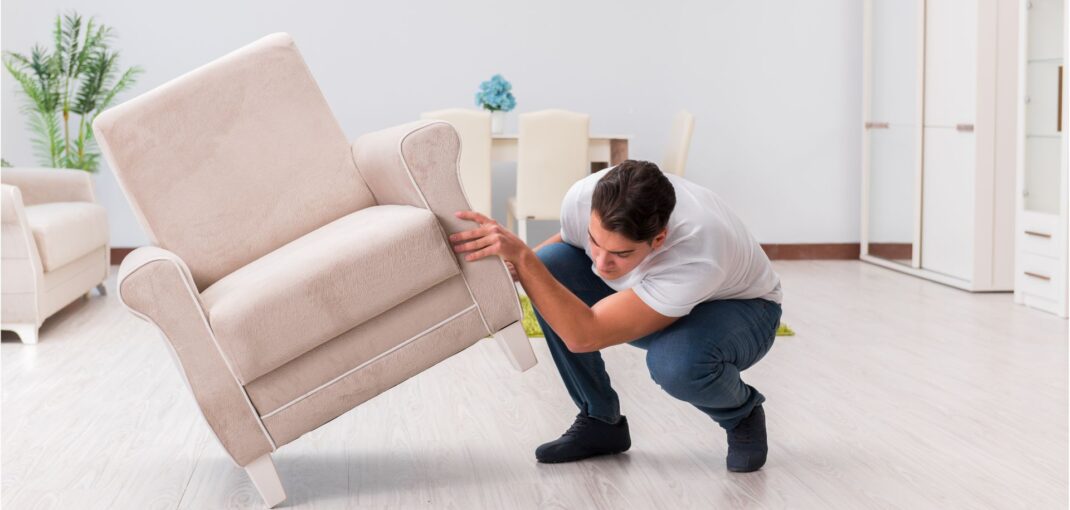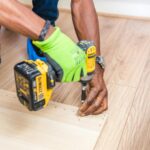You’ve finally decided to take the plunge and treat yourself (and your home) to a brand new floor. Maybe you’ve gone for the hardwood you’ve always dreamed of in the dining room, or maybe you’re refreshing up the carpet in your much-loved family room. Perhaps you’re giving your home a total flooring makeover. It’s an exciting time, but how are you supposed to put a new floor in without moving your whole family out?
What to Do with Furniture When Getting New Flooring
Furniture and belongings must be out of the way in order for your new flooring to be installed. Exactly what you choose to do with your furniture will depend on several factors. You can start to formulate a plan by asking yourself a few questions:
How big is your new flooring project?
Do you plan to get new flooring in just one room or the whole house? If you just need to temporarily shift a small kitchenette table and two chairs to a balcony, that’s one thing. However, if you need to think about all the furniture in every room in your home, that’s another.How long will installation take?
You’ll also need to consider the time frame for the installation. If you’re on a tight schedule and need your furniture out fast that might change your game plan.
How big is your home?
If you have several spare rooms and a two car garage, you have more options to shift your furniture than if you live in a studio apartment in midtown.
What’s your budget?
When it comes to moving (and storing) furniture, it’s generally a choice between money and muscle. Can you carry a couch by yourself or with a buddy? Can you afford to pay someone else to do it? Or do you have funds to temporarily move it to a storage unit?
Do your hardwood floor or carpet installers move furniture?
Some companies may include furniture moving in their quote, although it’s not a standard. If you do have this option, it can save you time (and maybe a sore back!). However, it may increase the total cost of your installation.
Once you have the answers to those questions, you will probably have enough information to choose between these three main strategies for dealing with your furniture while your new flooring is installed:
Musical Chairs
Simply, move your furniture to another room while your new flooring is being installed. If you’re having multiple rooms refloored, it may mean a lot of moving and carrying from room to room. It’s hard work, but it doesn’t cost a dime — and your beloved armchair never has to leave the house.
Garage or Shed Storage
This option only works if you have outdoor storage space. A shed or garage can be a makeshift home for your furniture while you’re putting in a new floor. However, you must be confident that the facilities are waterproof and secure to avoid damage to your furnishings. Otherwise, this is an extremely convenient option.
Short-Term Storage
Renting a storage unit for a full month may be overkill for a small flooring project, but it can make life a lot easier. This rings especially true if you live in tight quarters or if you’re flooring more than one space in your house. Rented storage is convenient, safe, and secure. No constant shuffling of chairs and tables or tripping over furniture awkwardly crammed into the wrong room. If you really want to give yourself a break, you can also hire someone to move it there.
Preparing Your Floor for Hardwood Installation
Once your furniture is out of the way, there are a few steps you can take to ensure a smooth and seamless installation:
- Before you get started, remove baseboards and door frames. This will make it much easier for your installation team to get a perfect fit. No matter what kind of flooring you currently have, a thorough vacuuming will make the rest of the job even easier.
- Ask your installers ahead of time whether they’ll be the ones removing your old flooring or if the job falls to you. If not, you may have a big job ahead of you: there can be some interesting surprises lurking under your old flooring. Multiple layers of carpet or vinyl can be difficult to move and are generally a lot heavier than they look!
- Once the old flooring has been taken out, you’ll need to ensure that the subfloor is level and in good condition before installation begins. Again, an experienced hardwood flooring installation specialist can take care of this for you to ensure a perfectly smooth and level finish on your new floor.
How to Prepare for Carpet Installation
The prep work for a new carpet is quite similar to the process for installing hardwood; however, there are a few differences.
- Once you’ve moved your furniture out, you generally need to get rid of the old flooring before your beautiful new carpet can be installed. For some helpful tips on getting rid of your existing carpeting for a fresh start.
- If you currently have wood or vinyl flooring, you may be able to lay the carpet over your existing flooring instead of tearing it out. However, it’s best to consult with your installation company about what options are available to you and what’s best for you and your new carpet.
Tips to Prep Your Home Before Floor Installation
Here are a few more tips to keep in mind before you put down your new flooring:
- Finish any home remodeling tasks. One of the best things you can do before you install a new floor is to complete any other remodeling jobs in the room first. Whether it’s a fresh coat of paint, new wallpaper, or general repairs, wrapping up these projects in advance will help protect your beautiful new floor from damage.
- Large appliance maintenance. If new flooring is going into a room with large appliances that may need to be rewired before moving, be sure to contact an electrician well in advance of your floor installation appointment. In case your appliances need to be moved, there’s less worry about a heavy piece of machinery scuffing up old floors before you install your new ones.
- Stock up on tarps and masking tape. If you anticipate a lot of sanding, you can minimize the spread of dust throughout the house by closing doors and covering them with sheets of plastic, tarps, and masking tape. Hardwood floors often require some sanding during the installation process. Similarly, if your subfloor needs a lot of work before carpet installation, your installation team may need to even out your floor so that it’s level. Having these simple items on-hand can make cleanup less intensive after your install.
- Be mindful of your pets. You’ll also want to consider finding your furry friends some alternate accommodation during installation. The disruption of strangers carrying large objects in and out of rooms, strange smells and sounds can be upsetting to cats or dogs. Worse yet, open doors can be an invitation to go AWOL. If you own birds or small animals such as rodents, be aware that they can have very sensitive respiratory systems. Check with your vet before installation whether they could be at risk from installation-related dust or fumes and make a plan to have a trusted friend or relative care for them for a few days until the (literal) dust settles.
We hope these tips help make it easier to plan ahead for installing new flooring. If you’re thinking about sprucing up your home and adding a fresh flooring element, Get an At Home Expert estimate to find out just how much flooring you’ll need to better pin down your project’s budget.






